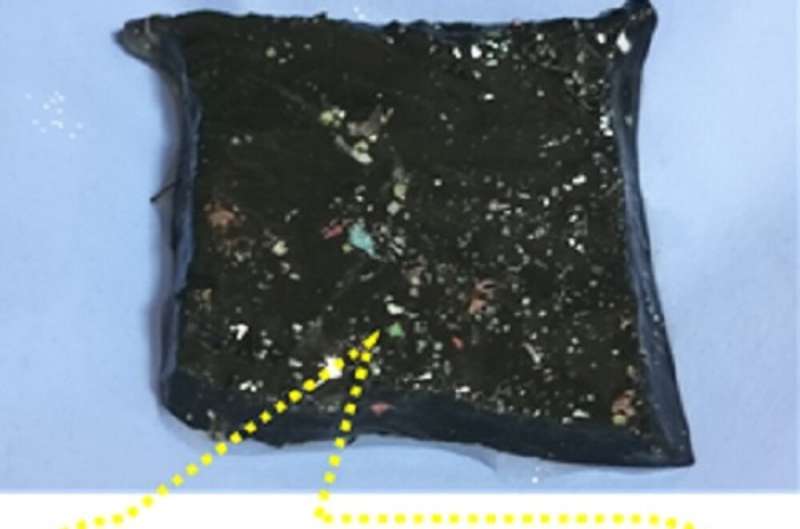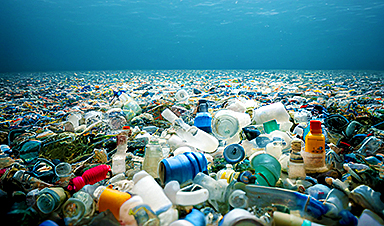Microplastics pose a great threat to human health. These tiny plastic debris can enter our bodies through the water we drink and increase the risk of illnesses. They are also an environmental hazard; found even in remote areas like polar ice caps and deep ocean trenches, they endanger aquatic and terrestrial lifeforms.
To combat this emerging pollutant, researchers at the Indian Institute of Science (IISc) have designed a sustainable hydrogel to remove microplastics from water. The material has a unique intertwined polymer network that can bind the contaminants and degrade them using UV light irradiation. The research is published in the journal Nanoscale.
Scientists have previously tried using filtering membranes to remove microplastics. However, the membranes can become clogged with these tiny particles, rendering them unsustainable. Instead, the IISc team led by Suryasarathi Bose, Professor at the Department of Materials Engineering, decided to turn to 3D hydrogels.
The novel hydrogel developed by the team consists of three different polymer layers—chitosan, polyvinyl alcohol and polyaniline—intertwined together, making an Interpenetrating Polymer Network (IPN) architecture. The team infused this matrix with nanoclusters of a material called copper substitute polyoxometalate (Cu-POM).
These nanoclusters are catalysts that can use UV light to degrade the microplastics. The combination of the polymers and nanoclusters resulted in a strong hydrogel with the ability to adsorb and degrade large amounts of microplastics.

Credit: Soumi Dutta
Most microplastics are a product of the incomplete breakdown of household plastics and fibers. To mimic this in the lab, the team crushed food container lids and other daily-use plastic products to create two of the most common microplastics existing in nature: polyvinyl chloride and polypropylene.
“Along with treatment or removal of microplastics, another major problem is detection. Because these are very small particles, you cannot see them with the naked eye,” explains Soumi Dutta, first author of the study and SERB National Post-doctoral fellow at the Department of Materials Engineering.
To solve this problem, the researchers added a fluorescent dye to the microplastics to track how much was being adsorbed and degraded by the hydrogel under different conditions. “We checked the removal of microplastics at different pH levels of water, different temperatures, and different concentrations of microplastics,” explains Dutta.
The hydrogel was found to be highly efficient—it could remove about 95% and 93% of the two different types of microplastics in water at near-neutral pH (∼6.5). The team also carried out several experiments to test how durable and strong the material was. They found that the combination of the three polymers made it stable under various temperatures.

Credit: Soumi Dutta
“We wanted to make a material that is more sustainable and can be used repetitively,” explains Bose. The hydrogel could last for up to five cycles of microplastic removal without significant loss of efficacy. What’s more, Bose points out, is that once it has outlived its use, the hydrogel can be repurposed into carbon nanomaterials that can remove heavy metals like hexavalent chromium from polluted water.
Moving forward, the researchers plan to work with collaborators to develop a device that can be deployed on a large scale to help clean up microplastics from various water sources.
More information: Soumi Dutta et al, Polyoxometalate nanocluster-infused triple IPN hydrogels for excellent microplastic removal from contaminated water: detection, photodegradation, and upcycling, Nanoscale (2024). DOI: 10.1039/D3NR06115A
Journal information: Nanoscale
Provided by Indian Institute of Science
News
Studies detail high rates of long COVID among healthcare, dental workers
Researchers have estimated approximately 8% of Americas have ever experienced long COVID, or lasting symptoms, following an acute COVID-19 infection. Now two recent international studies suggest that the percentage is much higher among healthcare workers [...]
Melting Arctic Ice May Unleash Ancient Deadly Diseases, Scientists Warn
Melting Arctic ice increases human and animal interactions, raising the risk of infectious disease spread. Researchers urge early intervention and surveillance. Climate change is opening new pathways for the spread of infectious diseases such [...]
Scientists May Have Found a Secret Weapon To Stop Pancreatic Cancer Before It Starts
Researchers at Cold Spring Harbor Laboratory have found that blocking the FGFR2 and EGFR genes can stop early-stage pancreatic cancer from progressing, offering a promising path toward prevention. Pancreatic cancer is expected to become [...]
Breakthrough Drug Restores Vision: Researchers Successfully Reverse Retinal Damage
Blocking the PROX1 protein allowed KAIST researchers to regenerate damaged retinas and restore vision in mice. Vision is one of the most important human senses, yet more than 300 million people around the world are at [...]
Differentiating cancerous and healthy cells through motion analysis
Researchers from Tokyo Metropolitan University have found that the motion of unlabeled cells can be used to tell whether they are cancerous or healthy. They observed malignant fibrosarcoma [...]
This Tiny Cellular Gate Could Be the Key to Curing Cancer – And Regrowing Hair
After more than five decades of mystery, scientists have finally unveiled the detailed structure and function of a long-theorized molecular machine in our mitochondria — the mitochondrial pyruvate carrier. This microscopic gatekeeper controls how [...]
Unlocking Vision’s Secrets: Researchers Reveal 3D Structure of Key Eye Protein
Researchers have uncovered the 3D structure of RBP3, a key protein in vision, revealing how it transports retinoids and fatty acids and how its dysfunction may lead to retinal diseases. Proteins play a critical [...]
5 Key Facts About Nanoplastics and How They Affect the Human Body
Nanoplastics are typically defined as plastic particles smaller than 1000 nanometers. These particles are increasingly being detected in human tissues: they can bypass biological barriers, accumulate in organs, and may influence health in ways [...]
Measles Is Back: Doctors Warn of Dangerous Surge Across the U.S.
Parents are encouraged to contact their pediatrician if their child has been exposed to measles or is showing symptoms. Pediatric infectious disease experts are emphasizing the critical importance of measles vaccination, as the highly [...]
AI at the Speed of Light: How Silicon Photonics Are Reinventing Hardware
A cutting-edge AI acceleration platform powered by light rather than electricity could revolutionize how AI is trained and deployed. Using photonic integrated circuits made from advanced III-V semiconductors, researchers have developed a system that vastly [...]
A Grain of Brain, 523 Million Synapses, Most Complicated Neuroscience Experiment Ever Attempted
A team of over 150 scientists has achieved what once seemed impossible: a complete wiring and activity map of a tiny section of a mammalian brain. This feat, part of the MICrONS Project, rivals [...]
The Secret “Radar” Bacteria Use To Outsmart Their Enemies
A chemical radar allows bacteria to sense and eliminate predators. Investigating how microorganisms communicate deepens our understanding of the complex ecological interactions that shape our environment is an area of key focus for the [...]
Psychologists explore ethical issues associated with human-AI relationships
It's becoming increasingly commonplace for people to develop intimate, long-term relationships with artificial intelligence (AI) technologies. At their extreme, people have "married" their AI companions in non-legally binding ceremonies, and at least two people [...]
When You Lose Weight, Where Does It Actually Go?
Most health professionals lack a clear understanding of how body fat is lost, often subscribing to misconceptions like fat converting to energy or muscle. The truth is, fat is actually broken down into carbon [...]
How Everyday Plastics Quietly Turn Into DNA-Damaging Nanoparticles
The same unique structure that makes plastic so versatile also makes it susceptible to breaking down into harmful micro- and nanoscale particles. The world is saturated with trillions of microscopic and nanoscopic plastic particles, some smaller [...]
AI Outperforms Physicians in Real-World Urgent Care Decisions, Study Finds
The study, conducted at the virtual urgent care clinic Cedars-Sinai Connect in LA, compared recommendations given in about 500 visits of adult patients with relatively common symptoms – respiratory, urinary, eye, vaginal and dental. [...]





















